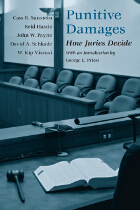

How do people decide whether or not to take chances with their health and safety? Do they pay attention to warnings about hazardous products used at home or on the job? What is the best way to present this information? These questions are becoming increasingly important as direct government regulation is replaced by programs to educate workers and consumers about risk. Information itself is becoming a regulatory device, but until now little has been known about its use and effectiveness.
Learning about Risk offers important new evidence on how people process information about risk and how they make choices under uncertainty. Drawing on work in a variety of disciplines—economics, decision science, marketing, and psychology—as well as on extensive original survey data, the authors take a close look at one type of risk information: the labeling of hazardous products and chemicals. They use the word labeling to mean all the tangible ways in which information is transmitted, including not merely warnings on bottles and cans but also leaflets and brochures, signs in the workplace, and store displays. The authors surveyed hundreds of consumers and chemical workers to explore a range of issues—the accuracy and appropriateness of people's risk assessments, the types of precautions they take, the values they attach to these measures, the wages they expect for performing risky jobs, and the relationship between the precaution taken and the content, wording, and format of the warning.
Overall, the authors show that information policies are a promising approach to controlling risks in the marketplace and on the job. Their findings will be of interest to government officials, policy analysts, economists, psychologists, and managers concerned professionally with the labeling of hazardous products.

But how do juries actually make decisions about punitive damages? To find out, the authors-experts in psychology, economics, and the law-present the results of controlled experiments with more than 600 mock juries involving the responses of more than 8,000 jury-eligible citizens. Although juries tended to agree in their moral judgments about the defendant's conduct, they rendered erratic and unpredictable dollar awards. The experiments also showed that instead of moderating juror verdicts, the process of jury deliberation produced a striking "severity shift" toward ever-higher awards. Jurors also tended to ignore instructions from the judges; were influenced by whatever amount the plaintiff happened to request; showed "hindsight bias," believing that what happened should have been foreseen; and penalized corporations that had based their decisions on careful cost-benefit analyses. While judges made many of the same errors, they performed better in some areas, suggesting that judges (or other specialists) may be better equipped than juries to decide punitive damages.
Using a wealth of new experimental data, and offering a host of provocative findings, this book documents a wide range of systematic biases in jury behavior. It will be indispensable for anyone interested not only in punitive damages, but also jury behavior, psychology, and how people think about punishment.
READERS
Browse our collection.
PUBLISHERS
See BiblioVault's publisher services.
STUDENT SERVICES
Files for college accessibility offices.
UChicago Accessibility Resources
home | accessibility | search | about | contact us
BiblioVault ® 2001 - 2024
The University of Chicago Press









